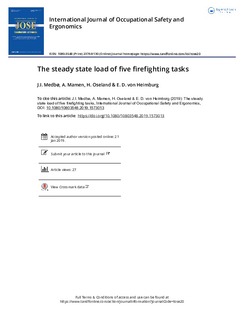| dc.contributor.author | Medbø, Jon Ingulf | |
| dc.contributor.author | Mamen, Asgeir | |
| dc.contributor.author | Oseland, Harald | |
| dc.contributor.author | Heimburg, Erna Dianne von | |
| dc.date.accessioned | 2019-03-18T08:38:16Z | |
| dc.date.available | 2019-03-18T08:38:16Z | |
| dc.date.created | 2019-03-06T13:09:48Z | |
| dc.date.issued | 2019-01-21 | |
| dc.identifier.citation | International Journal of Occupational Safety and Ergonomics. 2019, 21 . | nb_NO |
| dc.identifier.issn | 1080-3548 | |
| dc.identifier.uri | http://hdl.handle.net/11250/2590391 | |
| dc.description.abstract | Purpose. Physiologic demands of five common tasks in firefighting have been examined. Methods. Eight male volunteers, being dressed up as smoke divers (+21 kg extra load), carried out the following tasks at constant pace for 5 min: Walking at 1.4 m·s–1, walking (all walks at the same speed) while carrying a 10 kg ladder, walking carrying two hose packs of 16 kg together, walking carrying a 32 kg spreader tool, finally climbing up and down a ladder at preset pace. A 5 min break separated each exercise. Heart rate, O2-uptake and ventilation were measured continuously, and blood lactate con-centration was recorded after each task. Results. The end-exercise heart rate rose from 108 to 180 bpm from first to last task, blood lactate concentration rose from 1 to 7 mmol·L–1, O2-uptake rose from 19 to 48 ml·kg–1·min–1, and ventilation rose from 38 to 124 L·min–1. Discussion. Walking was an easy task even when dressed up as a smoke diver. Adding loads increased demands; ladder climbing taxed >90% of the subjects’ aerobic power. Conclusions. The physiologic demands varied considera-bly between different tasks. | nb_NO |
| dc.language.iso | eng | nb_NO |
| dc.rights | Navngivelse-DelPåSammeVilkår 4.0 Internasjonal | * |
| dc.rights.uri | http://creativecommons.org/licenses/by-sa/4.0/deed.no | * |
| dc.title | The steady state load of five firefighting tasks | nb_NO |
| dc.type | Journal article | nb_NO |
| dc.type | Peer reviewed | nb_NO |
| dc.description.version | acceptedVersion | nb_NO |
| dc.source.pagenumber | 13 | nb_NO |
| dc.source.volume | 21 | nb_NO |
| dc.source.journal | International Journal of Occupational Safety and Ergonomics | nb_NO |
| dc.identifier.doi | 10.1080/10803548.2019.1573013 | |
| dc.identifier.cristin | 1682591 | |
| cristin.ispublished | true | |
| cristin.fulltext | postprint | |
| cristin.qualitycode | 1 | |

